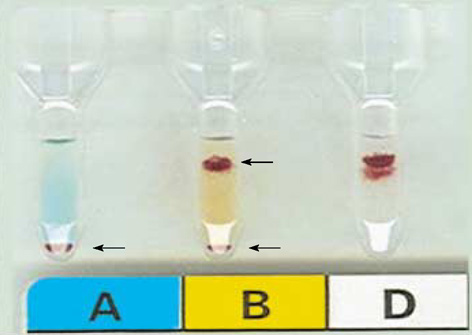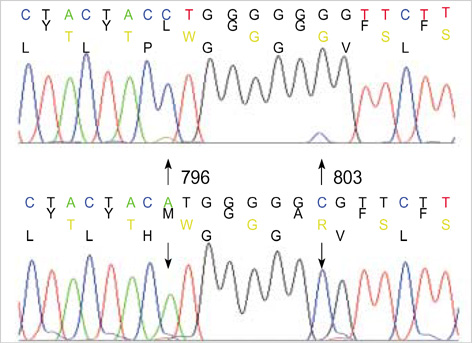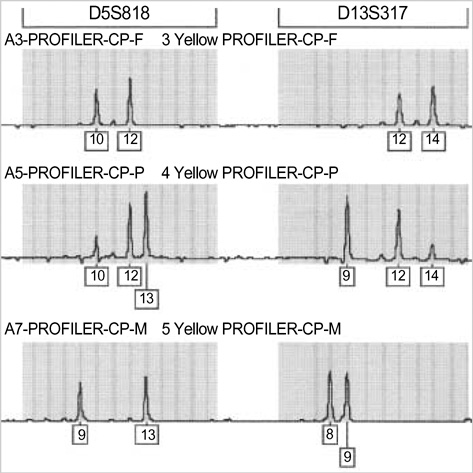J Korean Med Sci.
2007 Jun;22(3):553-556. 10.3346/jkms.2007.22.3.553.
A Dispermic Chimera with Mixed Field Blood Group B and Mosaic 46,XY/47,XYY Karyotype
- Affiliations
-
- 1Department of Laboratory Medicine, Chonnam National University Medical School, 8 Hark-dong, Dong-gu, Gwangju, Korea. dwryang@chonnam.ac.kr
- 2The Institute for Transfusion Medicine and Department of Pathology, University of Pittsburgh, Pittsburgh, U.S.A.
- 3Gwangju-Chonnam Red Cross Blood Center, Gwangju, Korea.
- 4Department of Forensic Medicine, Chonnam National Medical School, Gwangju, Korea.
- KMID: 1778370
- DOI: http://doi.org/10.3346/jkms.2007.22.3.553
Abstract
- Chimerism in humans is a rare phenomenon often initially identified in the resolution of an ABO blood type discrepancy. We report a dispermic chimera who presented with mixed field in his B antigen typing that might have been mistaken for the B3 subtype. The propositus is a healthy Korean male blood donor. Neither his clinical history nor initial molecular investigation of his ABO gene explained his mixed field agglutination with murine anti-B. Chimerism was suspected, and 9 short tandem repeat (STR) loci were analyzed on DNA extracted from blood, buccal swabs, and hair from this donor and on DNA isolated from peripheral blood lymphocytes from his parents. The propositus' red blood cells demonstrated mixed field agglutination with anti-B. Exon 6 and 7 and flanking intronic regions of his ABO gene were sequenced and revealed an O01/O02 genotype. B allele haplotype-specific PCR, along with exon 6 and 7 cloning and sequencing demonstrated a third ABO allele, B101. Four STR loci demonstrated a pattern consistent with a double paternal chromosome contribution in the propositus, thus confirming chimerism. His karyotype revealed a mosaic pattern: 32/50 metaphases were 46,XY and 18/50 metaphases demonstrated 47,XYY.
Keyword
MeSH Terms
Figure
Reference
-
1. Tippett P. Blood group chimeras. Vox Sang. 1983. 44:333–359.
Article2. Van Dijk BA, Boomsma DI, de Man AJ. Blood group chimerism in human multiple births is not rare. Am J Med Genet. 1996. 61:264–268.
Article3. Daniels G. Human Blood Groups. Blackwell Science. 1995. 1st ed. Oxford.
Article4. Gill TJ. Chimerism in humans. Transplant Proc. 1977. 9:1423–1431.5. Pruss A, Heymann GA, Hell A, Kalus UJ, Krausch D, Dorner T, Kiesewetter HH, Salama A. Acute intravascular hemolysis after transfusion of a chimeric RBC unit. Transfusion. 2003. 43:1449–1451.
Article6. Nielsen J, Wohlert M. Chromosome abnormalities found among 34,910 newborn children: results from a 13-year incidence study in Arhus, Denmark. Hum Genet. 1991. 87:81–83.7. Cho D, Jeon MJ, Oh BJ, Song JW, Shin MG, Shin JH, Suh SP, Ryang DW. A simplified ABO genotyping by allele-specific PCR. Korean J Lab Med. 2005. 25:92–97.8. Cho D, Kim SH, Jeon MJ, Choi KL, Kee SJ, Shin MG, Shin JH, Suh SP, Yazer MH, Ryang DW. The serological and genetic basis of the cis-AB blood group in Korea. Vox Sang. 2004. 87:41–43.
Article9. Mifsud NA, Haddad AP, Hart CF, Holdsworth R, Condon JA, Swain M, Sparrow RL. Serologic and molecular investigations of a chimera. Immunohematology. 1999. 15:100–104.10. Strain L, Warner JP, Johnston T, Bonthron DT. A human parthenogenetic chimera. Nature Genetics. 1995. 11:164–169.11. Drexler C, Glock B, Vadon M, Staudacher E, Dauber EM, Ulrich S, Reisacher RB, Mayr WR, Lanzer G, Wagner T. Tetragametic chimerism detected in a healthy woman with mixed-field agglutination reactions in ABO blood grouping. Transfusion. 2005. 45:698–703.
Article12. Wang JY, Samura O, Zhen DK, Cowan JM, Cardone V, Summers M, Bianchi DW. Fluorescence in-situ hybridization analysis of chromosomal constitution in spermatozoa from a mosaic 47,XYY/46,XY male. Mol Hum Reprod. 2000. 6:665–668.
Article




